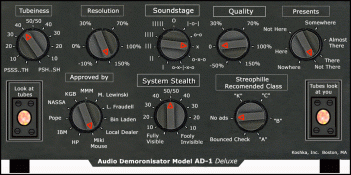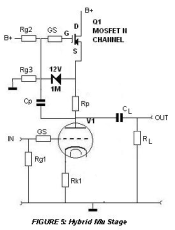thor.zmt
Well-known member
Folks,
Elsewhere in a different thread, the subject of the RPA came up. I think it is interesting form DIY, as it allows DIY'ers to make essentially very tubey tube circuits, that run on relatively low voltages (e.g. 24...48V), do not necessarily run the tubes in starved anode condition (but can) and can be powered if necessary from very low voltage power supplies.
I am sure some will argue that it does not give "true tube sound", but in my experience that depends on specific implementation. I'd like this thread to be specifically about the Theory, not about asking feedback on attempt's to make it work.
Originally the RPA was at least popularised, promoted and patented by Aphex. The Patent is expired and I would argue that the patent had no validity due to obviousness. Still, interesting in many ways.
Some so-called "high perveance" Tubes can operate very well at 48V. There is a white paper by Apex on a suitable circuit, mind you, I'd not use a 12AT7 in this circuit myself, but ECC88 or similar.

From here (link):
Aphex Tubessence White Paper
I have seen an earlier circuit from Aphex (IIRC) that used just a TO220 PNP Bipolar transistor and the tube heater as ballast for the transistor.
Like so (Aphex Patent):

I thought this circuit very interesting but never got around to trying the precise setup, but I have designed products around variations and refinements of "Tubessence" which were well received. I am attaching a commercial but discontinued design of mine, that is a "perfected" RPA. It was actually actually was quite liked by some studio people. Especially in the final mastering step.
Several 1,000 were made and sold and it's reliable. A review that describes the function is here:
iFi iTube Review
The "FX" is a version of Phaedrus "FRANCINSTIEN" (plus some extra) and the Taddeo "Digital Antidote II" respectively.
I apologise for the way it is drawn, which does not make the circuit easily to understand, I thought I had a file from TINA, but alas no. This schematic is for PCB design and the full product.

Here is a photo of the actual PCB:

You can see it is quite SMD part heavy.
The current through the tube is equal to the bias of the 2N4403 (MMBT4403 is the SMD version), so the tube operates in "starved anode" mode (~ 24V/0.1mA). Big advantage, extremely long life and ton's of harmonics. The second "advantage" was not one for "HiFI" use and the later version dropped HD a lot and used a much higher anode voltage and current.
The Mosfet can be replaced by IRF710 or similar without other change. Design center is 3V Vth which equates to 4mA in the 2N4403. The Mosfet follower at the output runs at ~10mA so max output into 600 Ohm is only 4.2V (+14dBU)
The follow-up version made a number of other changes. The PNP Transistor was replaced by a P-Channel Mosfet, the positive supply was raised to 48V from 24V, the current source NPN was replaced with Mosfet and most crucially a DC servo was added to eliminate the output capacitor and also the capacitors in the feedback loop. It is also a lot more complex and not really suited to DIY.
Should anyone wish to produce a commercial product based on this, I suggest to contact me for the updated version and other changes and naturally a licencing agreement. I can also help apply the same principle to other products (e.g. Microphone Pre etc.).
The circuit posted here is completely depreciated and outdated and not recommend for mass production, but it is suitable for DIY assembly, once the SMD parts are replaced by TH parts.
I would still roll in some of the updates I applied to the later version and rearrange the feedback loop to include the coupling Cap and feedback DC blocking Cap.
Thor
Elsewhere in a different thread, the subject of the RPA came up. I think it is interesting form DIY, as it allows DIY'ers to make essentially very tubey tube circuits, that run on relatively low voltages (e.g. 24...48V), do not necessarily run the tubes in starved anode condition (but can) and can be powered if necessary from very low voltage power supplies.
I am sure some will argue that it does not give "true tube sound", but in my experience that depends on specific implementation. I'd like this thread to be specifically about the Theory, not about asking feedback on attempt's to make it work.
Originally the RPA was at least popularised, promoted and patented by Aphex. The Patent is expired and I would argue that the patent had no validity due to obviousness. Still, interesting in many ways.
Some so-called "high perveance" Tubes can operate very well at 48V. There is a white paper by Apex on a suitable circuit, mind you, I'd not use a 12AT7 in this circuit myself, but ECC88 or similar.

From here (link):
Aphex Tubessence White Paper
I have seen an earlier circuit from Aphex (IIRC) that used just a TO220 PNP Bipolar transistor and the tube heater as ballast for the transistor.
Like so (Aphex Patent):

I thought this circuit very interesting but never got around to trying the precise setup, but I have designed products around variations and refinements of "Tubessence" which were well received. I am attaching a commercial but discontinued design of mine, that is a "perfected" RPA. It was actually actually was quite liked by some studio people. Especially in the final mastering step.
Several 1,000 were made and sold and it's reliable. A review that describes the function is here:
iFi iTube Review
The "FX" is a version of Phaedrus "FRANCINSTIEN" (plus some extra) and the Taddeo "Digital Antidote II" respectively.
I apologise for the way it is drawn, which does not make the circuit easily to understand, I thought I had a file from TINA, but alas no. This schematic is for PCB design and the full product.

Here is a photo of the actual PCB:

You can see it is quite SMD part heavy.
The current through the tube is equal to the bias of the 2N4403 (MMBT4403 is the SMD version), so the tube operates in "starved anode" mode (~ 24V/0.1mA). Big advantage, extremely long life and ton's of harmonics. The second "advantage" was not one for "HiFI" use and the later version dropped HD a lot and used a much higher anode voltage and current.
The Mosfet can be replaced by IRF710 or similar without other change. Design center is 3V Vth which equates to 4mA in the 2N4403. The Mosfet follower at the output runs at ~10mA so max output into 600 Ohm is only 4.2V (+14dBU)
The follow-up version made a number of other changes. The PNP Transistor was replaced by a P-Channel Mosfet, the positive supply was raised to 48V from 24V, the current source NPN was replaced with Mosfet and most crucially a DC servo was added to eliminate the output capacitor and also the capacitors in the feedback loop. It is also a lot more complex and not really suited to DIY.
Should anyone wish to produce a commercial product based on this, I suggest to contact me for the updated version and other changes and naturally a licencing agreement. I can also help apply the same principle to other products (e.g. Microphone Pre etc.).
The circuit posted here is completely depreciated and outdated and not recommend for mass production, but it is suitable for DIY assembly, once the SMD parts are replaced by TH parts.
I would still roll in some of the updates I applied to the later version and rearrange the feedback loop to include the coupling Cap and feedback DC blocking Cap.
Thor









